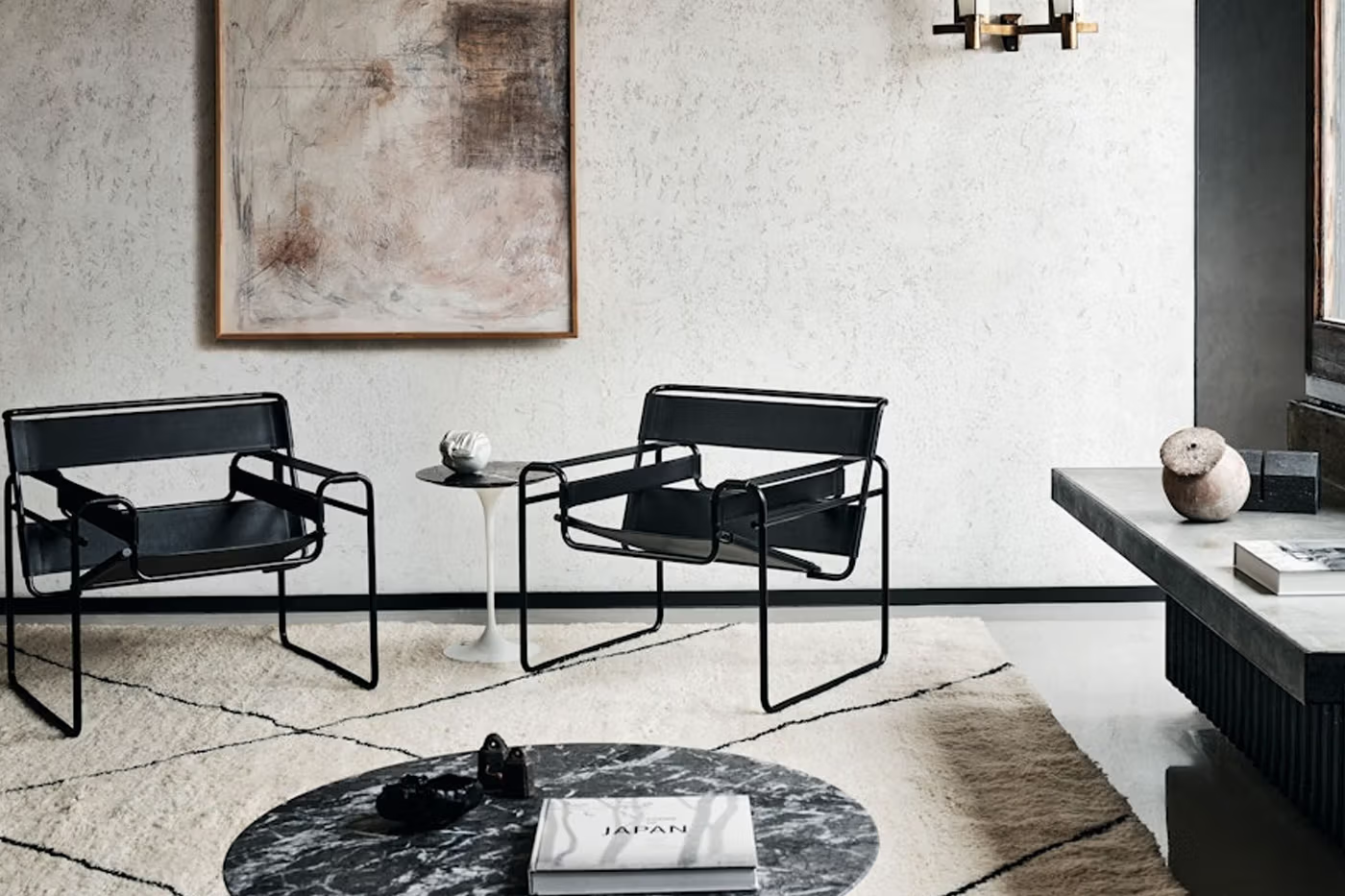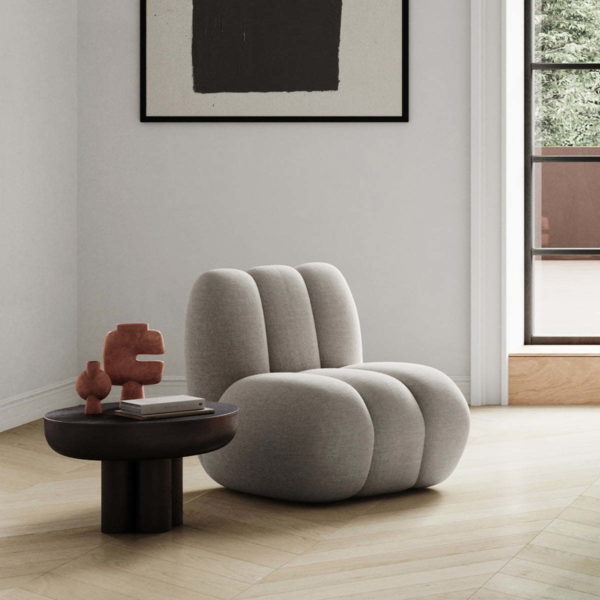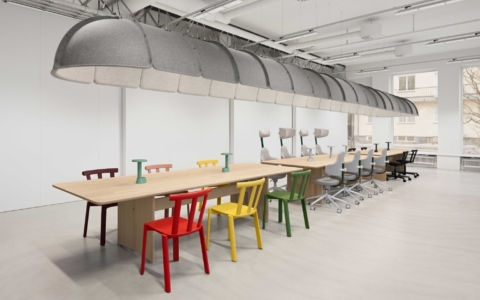6 Highlights from Trends & Traditions 2024

Copenhagen’s Trends & Traditions fair, now in its ninth year, has grown to become a firm fixture in the annual design calendar. Hosted in the city’s industrial Lokomotivværkstedet, a former train workshop, it’s an ideal engine for drawing together designers, architects and manufacturers from Scandinavia and beyond.
Trends & Traditions prides itself on providing a platform to celebrate and disseminate new innovations in materiality and making processes, but what especially caught our eye at this year’s edition was a focus on revisiting the past and finding fresh life in classic pieces and timeworn craft and manufacturing techniques.
Across the board, brands found new ways to revitalise pieces from their back catalogues, highlighting to visitors that newness for newness’s sake is not the way forward. Instead, companies showed more thoughtful treatments of classic pieces and processes – an approach highlighting the importance of more sustainable, connected thinking within furniture design.
As our team explored Trends & Traditions and everything it had to offer, the fair provided a reminder of the design decisions that have made some of the world’s most recognisable furniture pieces so successful and maintained their relevance across time. Read on for a few of our highlights.

Fredericia – The Spanish Chair
Instantly recognisable for its tan leather saddle and wide, generous armrests, Børge Mogensen’s Spanish Chair occupies a central place in the contemporary design canon. Mogensen designed the piece for Fredericia in 1958, inspired by chairs he had come across during a trip through Andalusia, and The Spanish Chair has not aged a day since then. Its belted leather saddle and backrest are not only beautiful, but also ensure these elements are replaceable, fully in keeping with increasing recognition of the importance of repair and restoration within furniture design. The fact that Fredericia offers a 25-year warranty on the piece is a tribute to the longevity of Mogensen's design, as well as the durability and robustness of the materials and manufacturing processes that go into it.

Fredericia – The Mogensen Sofa
The lessons of The Spanish Chair are evident in another classic from Fredericia and Mogensen: the 2213 Sofa, which the designer created for his own home in 1962. The piece remains in production today, but the real treat of Trends & Traditions was the opportunity to see Mogensen’s original, exhibited by the brand to highlight the enduring quality and durability of the design. Bar some mild wear on its brown leather cushions, which is only to be expected, the first 2213 remains in remarkable condition in spite of more than six decades of use. Sixty-two years on, Mogensen’s sofa continues to offer an important lesson for contemporary brands and designers: high-quality materials and careful craftsmanship will always last.


Blå Station – Able
If Fredericia highlighted the timelessness of its mid-century pieces, Sweden’s Blå Station showed that the principles of these classic designs can also be embodied by new work. Able, for instance, is a new armchair whose simple appearance (a tubular steel frame whose form the brand likens to pick-up sticks) conceals its thoughtful construction. Able is 100 per cent separable, providing the opportunity to replace, recycle or customise every element of the design – an intelligent focus on long life and durability that resonated with the designers on our team. Able may be a new design, but it has undeniably been created with the future in mind.

Brunner – Ray Work
Designed by Jehs+Laub for Brunner, the Ray chair began life in 2015 as a cantilevered chair, but has since blossomed into a whole family of lounge, bar and swivel chairs. Trends & Traditions saw a new addition to the family with Ray Work, a smartly conceived hybrid piece that sits somewhere between a collaboration, meeting and desk chair. Available in a colour palette that ranges across clay, lava, sand and earth, Ray Work showed a sensitive adaptation of an existing chair to meet new purposes, showing manufacturers the value of revisiting and reconsidering existing designs whenever seeking fresh ideas.

Knoll – Wassily Chair
Marcel Breuer’s Bauhaus classic requires no introduction, but it was fascinating to see the manner in which Knoll has continued to adapt the design to maintain its relevance and appeal for contemporary audiences. The 1925 original featured polished chrome tubing, inspired by the frame of a bicycle, but Knoll took the opportunity at Trends & Traditions to show a version that replaced the Wassily’s silvered metal with a black powder-coated frame. It may be a small tweak, but one that changes the character of the chair and helps it find new audiences. As the Wassily approaches its centenary, there’s new life in its design yet.

101 Copenhagen – Toe, Temple and Foku
Designers Kristian Sofus Hansen and Tommy Hyldahl showed a range of pieces for Danish brand 101 Copenhagen, offering furniture that drew on references as diverse as 70s Space Age to Japanese zen gardens. Although their inspirations may have been diffuse, Hansen and Hyldahl’s approach was consistent, luxuriating in high-quality materials and beautiful sculptural forms that will endure through time: their Toe chair is voluminous and beckoning, pairing well with the more geometric, mysterious forms of the Foku seating range. The Temple coffee table, meanwhile, is a simple play between two limestone blocks, but one that draws interest through its contrasting polished and rough textures – an enduring celebration of material.


TFP Journal
See moreNeoCon 2023 Highlights
06.07.23
The TFP US team recaps highlights from NeoCon 2023.
Explore More




